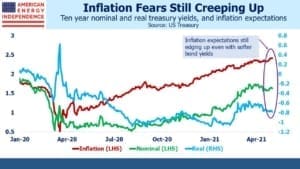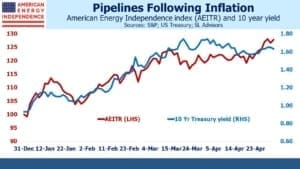The Fed Is Losing Believers
This Friday’s non-farm payroll report is more important than normal. With the Fed in single-minded pursuit of half their twin mandate (maximum employment), the stable prices objective is receding. The recent stalling in the bond market sell-off doesn’t correspond to equanimity over inflation. Declining real rates have accompanied the drop in nominal ones. In April, ten-year treasury yields dropped by 9bps, but TIPs yields fell by 0.13%. So inflation expectations edged up by 4bps. Investors now expect CPI inflation to average 2.42% over the next decade.
The Fed has a stated goal of 2% inflation over the long term and plans to tolerate inflation above this level during a recovery in order to anchor expectations at 2%. Investors are increasingly skeptical. Moreover, real yields are now solidly negative. They crossed below 0% for the first time during Covid early last year and have never recovered. With the Fed buying $120BN in bonds per month, partial debt monetization in support of higher employment is government policy. Stephanie Kelton’s book, The Deficit Myth, explains all (see Modern Monetary Theory Goes Mainstream).
It is a populist policy – voters are more aware of the cost of borrowing than the return on lending. And stocks are near all-time highs, so there’s little obviously wrong. But rising inflation expectations are a warning that the Fed will at some point need to confront a policy that has gone too far. The FOMC is not good at forecasting (Bond Investors Are Right To Worry).
In Fed chair Powell’s recent press conference, he said, “So it seems unlikely, frankly, that we would see inflation moving up in a persistent way that would actually move inflation expectations up while there was still significant slack in the labor market.”
Powell added, “…for inflation to move up in a persistent way that really starts to move inflation expectations up, that would have to—that would take some time and you would think it would be quite likely that we’d be in very strong labor markets for that to be happening.”
Put together, Powell doesn’t expect inflation expectations to rise until (a) actual inflation is rising, and (b) we are approaching full employment. Inflation expectations have been rising for over a year, and passed through the Fed’s 2% long term definition of price stability in early January. His comments sound as if he believes expectations will respond to actual inflation, whereas markets are forward-looking.
It sounds as if Powell doesn’t believe inflation expectations are rising.
On Saturday, Warren Buffett responded to a question by noting, “This economy right now, 85% of it is running in super high gear, and you’re seeing some inflation…” In another response, he said, “We’re seeing very substantial inflation. It’s very interesting. We’re raising prices. People are raising prices to us, and it’s being accepted.” Even Treasury Secretary and former Fed chair Janet Yellen said, “It may be that interest rates will have to rise somewhat to make sure that our economy doesn’t overheat…”
The list of those who share Jay Powell’s perspective is shrinking.
Anecdotal evidence of rising inflation is stacking up. Since the Fed is focused on maximum employment, every non-farm payroll report will be scrutinized for signs that this goal is within reach. Only wage inflation will justify a shifting monetary stance – all other forms are temporary (supply constraints), mean reverting (food and energy) or ignored completely (housing).
One could interpret persistent negative real yields as an indication that the Fed’s bond buying has continued too long. Credit doesn’t seem tight – the high yield bond market remains firm. It’s almost as if the Fed selectively accepts only data that supports its view. To listen to Jay Powell’s frustration with constant questions on inflation, a behavioral finance expert might diagnose overconfidence. The FOMC has misplaced high conviction around current policies.
Last week Dallas Fed president Robert Kaplan said, “At the earliest opportunity, I think it will be appropriate for us to start talking about adjusting those purchases,” He’s the first to openly break ranks.
JPMorgan expects Friday’s non-farm payroll report to show an increase of one million jobs. Jay Powell noted that 8.5 million fewer jobs exist than was the case pre-Covid. The actual slack in the economy may be less than that – Friday’s report will provide further evidence of the economy’s strong recovery.
Pipeline stocks have performed well as a hedge against rising inflation expectations. That’s likely to continue.
We are invested in all the components of the American Energy Independence Index via the ETF that seeks to track its performance.
Important Disclosures
The information provided is for informational purposes only and investors should determine for themselves whether a particular service, security or product is suitable for their investment needs. The information contained herein is not complete, may not be current, is subject to change, and is subject to, and qualified in its entirety by, the more complete disclosures, risk factors and other terms that are contained in the disclosure, prospectus, and offering. Certain information herein has been obtained from third party sources and, although believed to be reliable, has not been independently verified and its accuracy or completeness cannot be guaranteed. No representation is made with respect to the accuracy, completeness or timeliness of this information. Nothing provided on this site constitutes tax advice. Individuals should seek the advice of their own tax advisor for specific information regarding tax consequences of investments. Investments in securities entail risk and are not suitable for all investors. This site is not a recommendation nor an offer to sell (or solicitation of an offer to buy) securities in the United States or in any other jurisdiction.
References to indexes and benchmarks are hypothetical illustrations of aggregate returns and do not reflect the performance of any actual investment. Investors cannot invest in an index and do not reflect the deduction of the advisor’s fees or other trading expenses. There can be no assurance that current investments will be profitable. Actual realized returns will depend on, among other factors, the value of assets and market conditions at the time of disposition, any related transaction costs, and the timing of the purchase. Indexes and benchmarks may not directly correlate or only partially relate to portfolios managed by SL Advisors as they have different underlying investments and may use different strategies or have different objectives than portfolios managed by SL Advisors (e.g. The Alerian index is a group MLP securities in the oil and gas industries. Portfolios may not include the same investments that are included in the Alerian Index. The S & P Index does not directly relate to investment strategies managed by SL Advisers.)
This site may contain forward-looking statements relating to the objectives, opportunities, and the future performance of the U.S. market generally. Forward-looking statements may be identified by the use of such words as; “believe,” “expect,” “anticipate,” “should,” “planned,” “estimated,” “potential” and other similar terms. Examples of forward-looking statements include, but are not limited to, estimates with respect to financial condition, results of operations, and success or lack of success of any particular investment strategy. All are subject to various factors, including, but not limited to general and local economic conditions, changing levels of competition within certain industries and markets, changes in interest rates, changes in legislation or regulation, and other economic, competitive, governmental, regulatory and technological factors affecting a portfolio’s operations that could cause actual results to differ materially from projected results. Such statements are forward-looking in nature and involves a number of known and unknown risks, uncertainties and other factors, and accordingly, actual results may differ materially from those reflected or contemplated in such forward-looking statements. Prospective investors are cautioned not to place undue reliance on any forward-looking statements or examples. None of SL Advisors LLC or any of its affiliates or principals nor any other individual or entity assumes any obligation to update any forward-looking statements as a result of new information, subsequent events or any other circumstances. All statements made herein speak only as of the date that they were made. r
Certain hyperlinks or referenced websites on the Site, if any, are for your convenience and forward you to third parties’ websites, which generally are recognized by their top level domain name. Any descriptions of, references to, or links to other products, publications or services does not constitute an endorsement, authorization, sponsorship by or affiliation with SL Advisors LLC with respect to any linked site or its sponsor, unless expressly stated by SL Advisors LLC. Any such information, products or sites have not necessarily been reviewed by SL Advisors LLC and are provided or maintained by third parties over whom SL Advisors LLC exercise no control. SL Advisors LLC expressly disclaim any responsibility for the content, the accuracy of the information, and/or quality of products or services provided by or advertised on these third-party sites.
All investment strategies have the potential for profit or loss. Different types of investments involve varying degrees of risk, and there can be no assurance that any specific investment will be suitable or profitable for a client’s investment portfolio.
Past performance of the American Energy Independence Index is not indicative of future returns.




I own TBT and KYN. Any other ideas?
I own TBT and KYN.